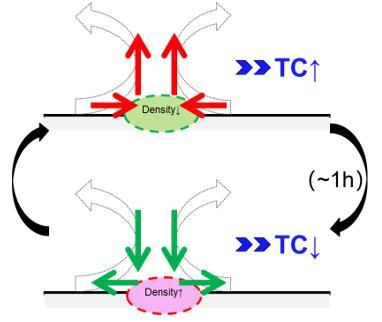How do high-frequency oscillations of tropical cyclones vary across the W North Pacific?

High-frequency oscillations and intensity of tropical cyclones. Credit: Shumin CHEN
Associate Researcher Shumin CHEN, Professor Weibiao LI and their team, from the School of Atmospheric Sciences, Sun Yat-Sen University, simulated several tropical cyclones using mesoscale numerical models.
As detailed in their paper, recently published in Advances in Atmospheric Sciences, they found that periods of high-frequency oscillations of tropical cyclones in the South China Sea are significantly shorter than those in the open water of the western North Pacific.
They further examined the dynamic and thermodynamic characteristics of all the tropical cyclones. Associate Researcher Shumin CHEN explains their findings:
“We examined the environmental vorticity, divergence, thermal winds, and the convergence winds in the lower layer. We found that the general features were similar in tropical cyclones in the South China Sea and the open western North Pacific, except that the convergence within the lower layer of tropical cyclones in the South China Sea was significantly larger than that in the open western North Pacific. Convergence enhanced by greater terrain friction in the South China Sea strengthened the disturbance and then contributed to the shorter oscillation periods”.
Professor Weibiao LI further explains that the study reveals the variations of high-frequency oscillation over different sea areas, and helps to improve the prediction of tropical cyclone intensity in different sea areas over the western North Pacific.
Media Contact
All latest news from the category: Earth Sciences
Earth Sciences (also referred to as Geosciences), which deals with basic issues surrounding our planet, plays a vital role in the area of energy and raw materials supply.
Earth Sciences comprises subjects such as geology, geography, geological informatics, paleontology, mineralogy, petrography, crystallography, geophysics, geodesy, glaciology, cartography, photogrammetry, meteorology and seismology, early-warning systems, earthquake research and polar research.
Newest articles

A ‘language’ for ML models to predict nanopore properties
A large number of 2D materials like graphene can have nanopores – small holes formed by missing atoms through which foreign substances can pass. The properties of these nanopores dictate many…

Clinically validated, wearable ultrasound patch
… for continuous blood pressure monitoring. A team of researchers at the University of California San Diego has developed a new and improved wearable ultrasound patch for continuous and noninvasive…

A new puzzle piece for string theory research
Dr. Ksenia Fedosova from the Cluster of Excellence Mathematics Münster, along with an international research team, has proven a conjecture in string theory that physicists had proposed regarding certain equations….



